

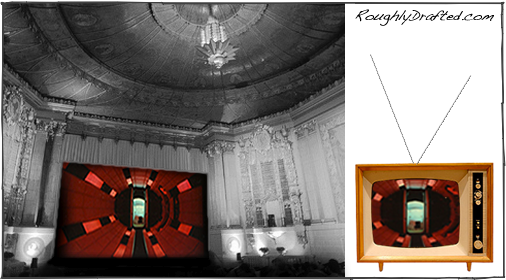
Back in the mid 90s, it appeared that both the studios’ panicked fears of home theater users and the brutal format wars were nearly under control. However, one other critical problem still had to be solved:
The studios had worked so hard to differentiate movies from television and create an experience that could not be duplicated at home, that now--somewhat ironically--solutions needed to be engineered for the technical problems of presenting those movies designed exclusively for theaters on home theater equipment.
As the industry inched toward DVD, Laserdisc and VHS users often ended up with poor transfers from the original theatrical movies sitting in studio’s warehouses.
Since television had a fixed screen ratio, studios took their existing wide aspect films and commonly just cut the sides off using ‘pan and scan’ techniques to get as much of the action as possible inside a full screen version of the original widescreen movie.
However, many movies had been designed specifically to show off the dramatic wide aspect ratios of widescreen movie formats, and subsequently lost a lot of their original character from the brutal editing required for pan and scan transfers to home theater formats.
Using letterboxing, the entire movie could be shown at the expense of blank areas at the top and bottom of the screen, but studios feared that consumers were more concerned about using the whole TV tube rather than seeing the whole movie.
This shot from Lady and the Tramp shows why pan and scan is used: putting the full glory of a CinemaScope film on TV requires blacking out a significant chunk of the screen with letterboxing, or cutting out half the picture to present a “full frame” version. On a widescreen TV, much less letterboxing is necessary.
The letterbox version feels like watching a movie, while the full screen version cuts the film into a cartoon.
In addition to the extra-wide picture problem, there was also no way to deliver the fancy six track audio designed for theatrical movies on home theater equipment.
Those extra channels of sound did not really make sense to deliver at home anyway, because most multichannel theater audio systems--including 70 mm Todd-AO--delivered five front channels and one rear surround channel.
Dolby Stereo Fixes Movie Sound.
As movies fell from their glorious golden age in the early 70s, new technologies helped to solve problems in the movie theater, and those solutions eventually impacted home theater as well.
The various multichannel magnetic soundtracks put on 70 mm prints for use in the fanciest theaters weren't practical, durable, or economical. In 1975, Dolby Labs introduced Dolby Stereo, a new high quality system that offered good sound that was easier and cheaper to deliver. 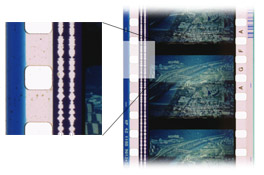

 Dolby's new system was backwardly compatible with existing equipment that optically read the basic soundtrack that had always been on movies; it used the same two channel optical recordings printed directly on standard 35 mm movie film.
Dolby's new system was backwardly compatible with existing equipment that optically read the basic soundtrack that had always been on movies; it used the same two channel optical recordings printed directly on standard 35 mm movie film. However, Dolby Stereo was more than just left and right stereo; it also added two new channels:
-
•a center channel that directs attention toward the stage
-
•a surround channel that provides immersive, ambient sound toward the rear
Using methods similar to the right and left stereo matrix on records and FM radio, Dolby Stereo adds a center channel to both channels, and then adds a surround channel, phase shifted 90 degrees.
When played through two speakers, the center channel is imaged by the brain of the listener between the two speakers, and the surround channel, being out of phase, creates an ambient, surrounding effect.
The Real Deal on Surround
Dolby Stereo surround effects don't actually require more than two speakers to hear because sound is perceived in the brain; stereo imaging only requires two ears on the listener, not a certain number of speakers.
While some insist that “real” surround effects require the maximum number of speakers currently being sold on the most expensive surround sound systems, that's principally because they're just excited about buying the most gold plated speaker wire connectors possible.
There is nothing “real” about vibrating a speaker coil to create sound, nor is there anything “real” about engineering a soundtrack that greatly exaggerates audio positioning. Many portable stereos similarly have a wide mode that creates eerily surrounding effects from regular sound inputs using just two speakers.
Taking Dolby Stereo Apart
While the psychoacoustics behind Dolby Stereo can be delivered by standard two channel stereo equipment, the stereo imaging effect is even greater when using special decoding and multiple speakers.
In Dolby Stereo, the surround channel is separated by doing a differential of the two channels, applying a low pass band filter to remove highly frequency distractions, and is output to speakers along the rear of the theater with a slight delay.
During the surround extraction, the center channel is turned 180 degrees out of phase and cancels itself out, following the same principle behind noise cancelation headphones. Similarly, the surround channel is also out of phase with the left and right channels, and therefore cancels out that duplication as well.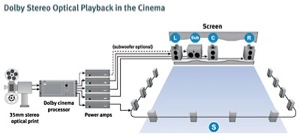

In addition to the out of phase noise cancelation effect, Dolby Stereo also performs a delay on the surround, exploiting the Haas Effect, a phenomenon where the brain ignores duplicate sounds from two sources heard within 30-40 milliseconds.
With a longer delay between two sounds, we hear a reverberating echo; using the Hass Effect, the brain can better localize sounds by ignoring unnecessary noise and only tuning into positioning cues that matter.
Dolby Stereo’s slight delay wipes the duplicate surround wave from perception, so the audience only hears center channel sound that appear to come from the stage, and surround sound that appears to envelop from behind.
The simplicity and flexibility of Dolby Stereo resolved several issues: it helped to ensure that all movies had a durable, high quality soundtrack that could scale from simple systems to more complex ones, and created an incentive for theater owners to upgrade their sound to take advantage of an audio feature that would now be ubiquitous, not just used on one or two big movies or as part of a fad.
Dolby Surround Comes Home



In 1982, Dolby introduced a version of the Dolby Stereo system for home equipment under the name Dolby Surround, followed by the greatly improved Dolby Surround Pro Logic in 1987, Pro Logic II in 2000, and IIx in 2004.
Since all modern movies have a Dolby Stereo soundtrack, when Laserdisc and Stereo VHS arrived the full theatrical sound from the movie ‘just worked’ on home stereo equipment. While Pro Logic was prohibitively expensive when it first came out, it has since been included on nearly all home stereo equipment.
Dolby's Pro Logic was also intended to present music with surround effects. However, because Pro Logic was created for movies it created an unnatural ‘center stage feel’ that a lot of people didn't like.
That’s why Pro Logic II offers two modes, one for movies with a strong center that directs attention toward the screen, and one for music that presents a more diffusely ambient sound.
Other attempts at recording and distributing multichannel sound for music, including a rash of “quadraphonic” attempts in the early and mid 70s, failed due the similar problems that had plagued theater sound in the early 70s: a chicken and egg situation of limited content and limited equipment.
Pushing the State of The Art.
Dolby's solution was not only elegant and inexpensive to deliver, but was also regarded as high quality. Its combination of elegant simplicity and economical distribution prepared a way for theatrical sound to be delivered cost effectively in home theater.
In the late 70s, a reemergence of theatrical technology pushed by movie makers helped raise the bar once again, creating another wave in the state of the art that would also eventually lap up on the shores of home theater.
A future article takes a look.
Like reading RoughlyDrafted? Share articles with your friends, link from your blog, and subscribe to my podcast!
Did I miss any details?
Next Articles:
Format Wars in Home Theater
Format Wars in Home Theater
This Series

Haloscan Q107
Lost in the Transition: Movies in Home Theater
Wednesday, April 11, 2007

Ad



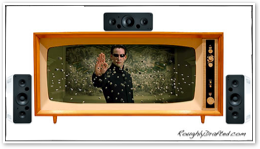
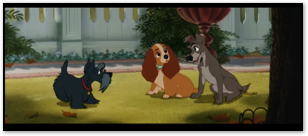
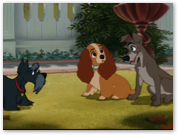
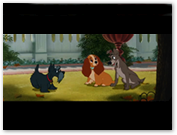
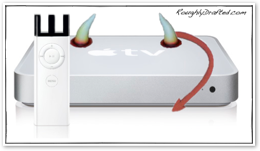
 Bookmark on Del.icio.us
Bookmark on Del.icio.us Discuss on Reddit
Discuss on Reddit Critically review on NewsTrust
Critically review on NewsTrust Forward to Friends
Forward to Friends
 Get RSS Feed
Get RSS Feed Download RSS Widget
Download RSS Widget





